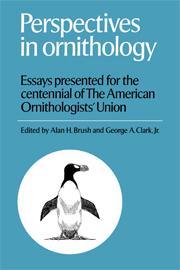 Perspectives in Ornithology
Perspectives in Ornithology Book contents
- Frontmatter
- Contents
- List of contributors
- Preface
- Introduction
- 1 Captive birds and conservation
- 2 Research collections in ornithology – a reaffirmation
- 3 On the study of avian mating systems
- 4 Cooperative breeding strategies among birds
- 5 Ecological energetics: what are the questions?
- 6 Perspectives in optimal foraging
- 7 Biochemical studies of microevolutionary processes
- 8 Organization of the avian genome
- 9 The origin and early radiation of birds
- 10 Avian community ecology: an iconoclastic view
- 11 Biogeography: the unification and maturation of a science
- 12 Bird song learning: theme and variations
- 13 Bird navigation
- Index
Introduction
Published online by Cambridge University Press: 04 August 2010
- Frontmatter
- Contents
- List of contributors
- Preface
- Introduction
- 1 Captive birds and conservation
- 2 Research collections in ornithology – a reaffirmation
- 3 On the study of avian mating systems
- 4 Cooperative breeding strategies among birds
- 5 Ecological energetics: what are the questions?
- 6 Perspectives in optimal foraging
- 7 Biochemical studies of microevolutionary processes
- 8 Organization of the avian genome
- 9 The origin and early radiation of birds
- 10 Avian community ecology: an iconoclastic view
- 11 Biogeography: the unification and maturation of a science
- 12 Bird song learning: theme and variations
- 13 Bird navigation
- Index
Summary
A science is like a tree. It is forever growing and reaching out in all directions. New branches develop, but some earlier branches may stop growing, being shaded out by the new branches. However, there is one aspect in which science seems to differ from a tree: The older it gets the more vigorous its growth seems to be.
This is certainly true for ornithology. If one takes Frederick II's De Arte Vanandi as the birth of ornithology, our Scientia amabilis had already reached a venerable age when the American Ornithologists' Union (AOU) was founded in 1883. In the first 50 years after the birth of the AOU, ornithology was largely a self-contained science, concerned primarily in problems of interest only to ornithologists and with most of its publications being suitable only for ornithological journals. This is well reflected in an overview of ornithology presented on the occasion of the fiftieth anniversary of the founding of the AOU (Chapman and Palmer 1933), reflecting interests that do not depart drastically from the ornithology of 1883. By contrast, if one compares the subjects included in the present volume with the state of ornithology as recently as 1962 as reflected in the Proceedings of the XIIIth International Ornithological Congress, Ithaca, one notices a decided change. Entirely new branches of ornithology are now dominant that had hardly been heard of in 1962 or had not existed at all. The recency of much of this research is reflected in the bibliographies.
- Type
- Chapter
- Information
- Perspectives in OrnithologyEssays Presented for the Centennial of the American Ornitholgists' Union, pp. 1 - 22Publisher: Cambridge University PressPrint publication year: 1983
- 2
- Cited by


